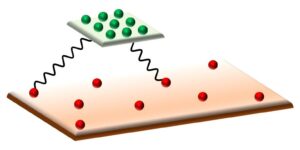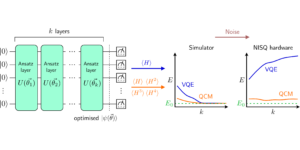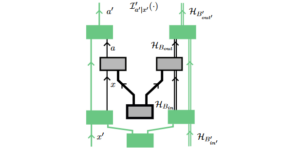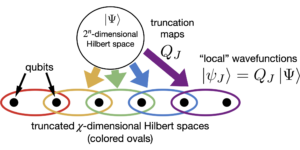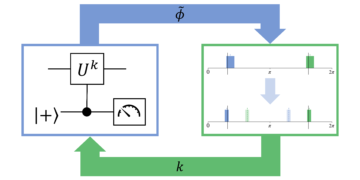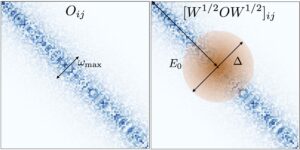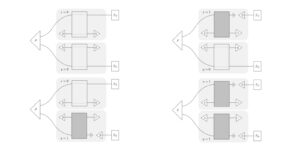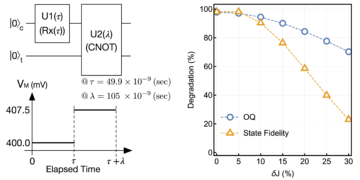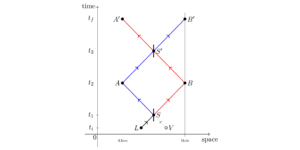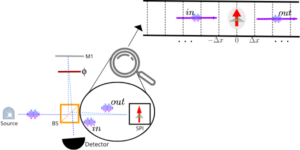1Fakultät für Informatik, University of Sussex, Großbritannien
2Quantinuum (Cambridge Quantum), Terrington House, 13-15 Hills Rd, Cambridge, CB2 1NL, Großbritannien
3Institut für Informatik und Technologie, Universität Cambridge, Großbritannien
Findest du dieses Paper interessant oder möchtest du darüber diskutieren? Scite oder hinterlasse einen Kommentar zu SciRate.
Abstrakt
Dieser Artikel basiert auf der Idee, Stabilisatorschaltungen durch Transformationen von {quadratischen Formentwicklungen} zu simulieren. Dies ist eine Darstellung eines Quantenzustands, die eine Formel für die Entwicklung in der Standardbasis angibt und reale und imaginäre relative Phasen unter Verwendung eines Polynoms 2. Grades über den ganzen Zahlen beschreibt. Wir zeigen, wie wir mit einer geschickten Verwaltung der quadratischen Formerweiterungsdarstellung einzelne Stabilisatoroperationen in $mathcal{O}(n^2)$-Zeit simulieren können, die der Gesamtkomplexität anderer Simulationstechniken entspricht [1,2,3]. Unsere Techniken bieten Skaleneffekte bei der Simulation simultaner Messungen aller (oder fast aller) Qubits auf Standardbasis. Unsere Techniken ermöglichen auch die Simulation von Einzel-Qubit-Messungen mit deterministischen Ergebnissen in konstanter Zeit. Wir beschreiben außerdem durchgehend, wie diese Grenzen verschärft werden können, wenn die Entwicklung des Zustands in der Standardbasis relativ wenige Terme hat (niedrigen „Rang“ hat) oder durch dünn besetzte Matrizen spezifiziert werden kann. Dies ermöglicht uns insbesondere die Simulation einer „lokalen“ Stabilisierungssyndrommessung in der Zeit $mathcal{O}(n)$ für einen Stabilisatorcode, der Pauli-Rauschen unterliegt – was mit den von Gidney entwickelten Techniken möglich ist [4], ohne dass gespeichert werden muss, welche Operationen bisher simuliert wurden.
► BibTeX-Daten
► Referenzen
[1] S. Aaronson und D. Gottesman, „Verbesserte Simulation von Stabilisatorschaltungen“, Physical Review A, vol. 70, nein. 5, November 2004. [Online]. Verfügbar: https:///doi.org/10.1103/physreva.70.052328 0pt.
https: / / doi.org/ 10.1103 / physreva.70.052328
[2] S. Anders und HJ Briegel, „Schnelle Simulation von Stabilisatorschaltungen mithilfe einer Graph-State-Darstellung“, Physical Review A, vol. 73, Nr. 2, Februar 2006. [Online]. Verfügbar: http:///doi.org/10.1103/PhysRevA.73.022334 0pt.
https: / / doi.org/ 10.1103 / PhysRevA.73.022334
[3] S. Bravyi, G. Smith und JA Smolin, „Trading Classical and Quantum Computational Resources“, Physical Review X, vol. 6, nein. 2. Juni 2016. [Online]. Verfügbar: http:///doi.org/10.1103/PhysRevX.6.021043 0pt.
https://doi.org/ 10.1103/PhysRevX.6.021043
[4] C. Gidney, „Stim: ein schneller Stabilisator-Schaltkreissimulator“, Quantum, Bd. 5, S. 497, Juli 2021. [Online]. Verfügbar: https:///doi.org/10.22331/q-2021-07-06-497 0pt.
https://doi.org/10.22331/q-2021-07-06-497
[5] P. Shor, „Algorithmen für die Quantenberechnung: diskrete Logarithmen und Faktorisierung“, S. 124–134, 1994. [Online]. Verfügbar: https:///doi.org/10.1109/SFCS.1994.365700 0pt.
https: / / doi.org/ 10.1109 / SFCS.1994.365700
[6] LK Grover, „Ein schneller quantenmechanischer Algorithmus für die Datenbanksuche“, in Proceedings of the Twenty-Eighth Annual ACM Symposium on Theory of Computing, ser. STOC '96. New York, NY, USA: Association for Computing Machinery, 1996, p. 212–219. [Online]. Verfügbar: https:///doi.org/10.1145/237814.237866 0pt.
https: / / doi.org/ 10.1145 / 237814.237866
[7] D. Gottesman, „The Heisenberg Representation of Quantum Computers“, arXiv e-prints, Juli 1998. [Online]. Verfügbar: https:///doi.org/10.48550/ARXIV.QUANT-PH/9807006 0pt.
https:///doi.org/10.48550/ARXIV.QUANT-PH/9807006
[8] SJ Devitt, WJ Munro und K. Nemoto, „Quantenfehlerkorrektur für Anfänger“, Reports on Progress in Physics, vol. 76, Nr. 7, S. 076001, Juni 2013. [Online]. Verfügbar: http:///doi.org/10.1088/0034-4885/76/7/076001 0pt.
https://doi.org/10.1088/0034-4885/76/7/076001
[9] BM Terhal, „Quantenfehlerkorrektur für Quantenspeicher“, Reviews of Modern Physics, vol. 87, Nr. 2, S. 307–346, April 2015. [Online]. Verfügbar: http:///doi.org/10.1103/RevModPhys.87.307 0pt.
https: / / doi.org/ 10.1103 / RevModPhys.87.307
[10] J. Roffe, „Quantum Error Correction: an Introductory Guide“, Contemporary Physics, Bd. 60, nein. 3, S. 226–245, Juli 2019. [Online]. Verfügbar: http:///doi.org/10.1080/00107514.2019.1667078 0pt.
https: / / doi.org/ 10.1080 / 00107514.2019.1667078
[11] S. Bravyi, D. Browne, P. Calpin, E. Campbell, D. Gosset und M. Howard, „Simulation von Quantenschaltungen durch niedrigrangige Stabilisatorzerlegungen“, Quantum, vol. 3, S. 181, September 2019. [Online]. Verfügbar: http:///doi.org/10.22331/q-2019-09-02-181 0pt.
https://doi.org/10.22331/q-2019-09-02-181
[12] N. de Beaudrap, V. Danos, E. Kashefi und M. Roetteler, „Quadratische Formerweiterungen für Unitarien“, in Theory of Quantum Computation, Communication, and Cryptography, Y. Kawano und M. Mosca, Hrsg. Berlin, Heidelberg: Springer Berlin Heidelberg, 2008, S. 29–46. [Online]. Verfügbar: https:///doi.org/10.1007/978-3-540-89304-2_4 0pt.
https://doi.org/10.1007/978-3-540-89304-2_4
[13] AR Calderbank und PW Shor, „Es gibt gute Codes zur Quantenfehlerkorrektur“, Physical Review A, vol. 54, Nr. 2, S. 1098–1105, August 1996. [Online]. Verfügbar: http:///doi.org/10.1103/PhysRevA.54.1098 0pt.
https: / / doi.org/ 10.1103 / PhysRevA.54.1098
[14] J. Dehaene und B. de Moor, „Clifford-Gruppe, Stabilisatorzustände und lineare und quadratische Operationen über GF(2)“, Physical Review A, vol. 68, nein. 4, S. 042318, Okt. 2003. [Online]. Verfügbar: https:///doi.org/10.1103/physreva.68.042318 0pt.
https: / / doi.org/ 10.1103 / physreva.68.042318
[15] M. Van Den Nest, „Klassische Simulation der Quantenberechnung, das Gottesman-Knill-Theorem und etwas darüber hinaus“, Quantum Info. Comput., vol. 10, nein. 3, März 2010. [Online]. Verfügbar: https:///doi.org/10.26421/QIC10.3-4-6 0pt.
https: / / doi.org/ 10.26421 / QIC10.3-4-6
[16] J. Bermejo-Vega und M. Van Den Nest, „Klassische Simulationen von Normalisierungsschaltungen der abelschen Gruppe mit Zwischenmessungen“, Quantum Information and Computation, vol. 14, Nr. 3&4, S. 181–0216, März 2014. [Online]. Verfügbar: https:///doi.org/10.26421/QIC14.3-4-1 0pt.
https: / / doi.org/ 10.26421 / QIC14.3-4-1
[17] M. Amy, „Towards Large-scale Functional Verification of Universal Quant Circuits“, Electronic Proceedings in Theoretical Computer Science, Bd. 287, S. 1–21, Januar 2019. [Online]. Verfügbar: http:///doi.org/10.4204/EPTCS.287.1 0pt.
https: / / doi.org/ 10.4204 / EPTCS.287.1
[18] D. Gross, „Hudsons Theorem für endlichdimensionale Quantensysteme“, Journal of Mathematical Physics, vol. 47, nein. 12, S. 122107, Dezember 2006. [Online]. Verfügbar: http:///doi.org/10.1063/1.2393152 0pt.
https: / / doi.org/ 10.1063 / 1.2393152
[19] N. de Beaudrap und S. Herbert, „Quantenlineare Netzwerkcodierung für die Verschränkungsverteilung in eingeschränkten Architekturen“, Quantum, vol. 4, S. 356, November 2020. [Online]. Verfügbar: https:///doi.org/10.22331/q-2020-11-01-356 0pt.
https://doi.org/10.22331/q-2020-11-01-356
[20] C. Guan und KW Regan, „Stabilisatorschaltungen, quadratische Formen und Berechnungsmatrixrang“, 2019. [Online]. Verfügbar: https:///doi.org/10.48550/arxiv.1904.00101 0pt.
https:///doi.org/10.48550/arxiv.1904.00101
[21] M. A. Nielsen und I. L. Chuang, Quantum Computation and Quantum Information: 10th Anniversary Edition, 10. Auflage. USA: Cambridge University Press, 2011. [Online]. Verfügbar: https:///doi.org/10.1017/CBO9780511976667 0pt.
https: / / doi.org/ 10.1017 / CBO9780511976667
[22] R. Jozsa und M. Van Den Nest, „Klassische Simulationskomplexität erweiterter Clifford-Schaltungen“, Quantum Info. Comput., vol. 14, Nr. 7&8, S. 633–648, Mai 2014. [Online]. Verfügbar: https:///doi.org/10.48550/arxiv.1305.6190 0pt.
https:///doi.org/10.48550/arxiv.1305.6190
[23] S. Bravyi und D. Gosset, „Verbesserte klassische Simulation von Quantenschaltungen, die von Clifford-Gates dominiert werden“, Physical Review Letters, vol. 116, Nr. 25. Juni 2016. [Online]. Verfügbar: http:///doi.org/10.1103/PhysRevLett.116.250501 0pt.
https://doi.org/ 10.1103/PhysRevLett.116.250501
[24] AG Fowler, M. Mariantoni, JM Martinis und AN Cleland, „Oberflächencodes: Auf dem Weg zur praktischen Quantenberechnung im großen Maßstab“, Physical Review A, vol. 86, Nr. 3, September 2012. [Online]. Verfügbar: http:///doi.org/10.1103/PhysRevA.86.032324 0pt.
https: / / doi.org/ 10.1103 / PhysRevA.86.032324
[25] AJ Landahl, JT Anderson und PR Rice, „Fault-tolerant Quantum Computing with Color Codes“, 2011. [Online]. Verfügbar: https:///doi.org/10.48550/arxiv.1108.5738 0pt.
https:///doi.org/10.48550/arxiv.1108.5738
[26] R. Chao und BW Reichardt, „Quantenfehlerkorrektur mit nur zwei zusätzlichen Qubits“, Physical Review Letters, vol. 121, Nr. 5. August 2018. [Online]. Verfügbar: http:///doi.org/10.1103/PhysRevLett.121.050502 0pt.
https://doi.org/ 10.1103/PhysRevLett.121.050502
[27] PW Shor, „Fehlertolerante Quantenberechnung“, in Proceedings of the 37th Annual Symposium on Foundations of Computer Science, ser. FOCS '96. USA: IEEE Computer Society, 1996, S. 56. [Online]. Verfügbar: https:///doi.org/10.1109/SFCS.1996.548464 0pt.
https: / / doi.org/ 10.1109 / SFCS.1996.548464
[28] DP DiVincenzo und P. Aliferis, „Effective Fault Tolerant Quantum Computation with Slow Measurements“, Physical Review Letters, vol. 98, nein. 2, Januar 2007. [Online]. Verfügbar: http:///doi.org/10.1103/PhysRevLett.98.020501 0pt.
https://doi.org/ 10.1103/PhysRevLett.98.020501
[29] CH Bennett, G. Brassard, S. Popescu, B. Schumacher, JA Smolin und WK Wootters, „Reinigung der lauten Verschränkung und treue Teleportation über laute Kanäle“, Phys. Rev. Lett., vol. 76, S. 722–725, Januar 1996. [Online]. Verfügbar: https:///doi.org/10.1103/physrevlett.76.722 0pt.
https://doi.org/ 10.1103/physrevlett.76.722
[30] R. Nigmatullin, CJ Ballance, N. de Beaudrap und SC Benjamin, „Minimally Complex Ion Traps as Modules for Quantum Communication and Computing“, New Journal of Physics, vol. 18, nein. 10, S. 103028, 2016. [Online]. Verfügbar: https:///doi.org/10.1088/1367-2630/18/10/103028 0pt.
https://doi.org/10.1088/1367-2630/18/10/103028
[31] W. Dür und HJ Briegel, „Verschränkungsreinigung und Quantenfehlerkorrektur“, Reports on Progress in Physics, vol. 70, nein. 8, S. 1381–1424, Juli 2007. [Online]. Verfügbar: http:///doi.org/10.1088/0034-4885/70/8/R03 0pt.
https://doi.org/10.1088/0034-4885/70/8/R03
[32] CM Dawson, AP Hines, D. Mortimer, HL Haselgrove, MA Nielsen und TJ Osborne, „Quantenrechnen und Polynomgleichungen über dem endlichen Feld Z2“, Quantum Info. Comput., vol. 5, nein. 2, S. 102–112, März 2005. [Online]. Verfügbar: https:///doi.org/10.48550/arxiv.quant-ph/0408129 0pt.
https:///doi.org/10.48550/arxiv.quant-ph/0408129
arXiv: quant-ph / 0408129
[33] M. Hein, J. Eisert und HJ Briegel, „Multiparty entanglement in graph states“, Physical Review A, vol. 69, nein. 6, Juni 2004. [Online]. Verfügbar: http:///doi.org/10.1103/PhysRevA.69.062311 0pt.
https: / / doi.org/ 10.1103 / PhysRevA.69.062311
[34] M. Hein, W. Dür, J. Eisert, R. Raussendorf, M. Nest und H. Briegel, „Verschränkung in Graphzuständen und ihre Anwendungen“, Quantum Computers, Algorithms and Chaos, vol. 162, 03 2006. [Online]. Verfügbar: https:///doi.org/10.3254/978-1-61499-018-5-115 0pt.
https://doi.org/10.3254/978-1-61499-018-5-115
[35] LE Heyfron und ET Campbell, „Ein effizienter Quantencompiler, der die T-Anzahl reduziert“, Quantum Science and Technology, vol. 4, nein. 1, S. 015004, September 2018. [Online]. Verfügbar: https:///doi.org/10.1088/2058-9565/aad604 0pt.
https: / / doi.org/ 10.1088 / 2058-9565 / aad604
[36] D. Gottesman und IL Chuang, „Demonstration der Machbarkeit universeller Quantenberechnungen mithilfe von Teleportation und Einzel-Qubit-Operationen“, Nature, vol. 402, nein. 6760, S. 390–393, 1999. [Online]. Verfügbar: https:///doi.org/10.1038/46503 0pt.
https: / / doi.org/ 10.1038 / 46503
[37] B. Zeng, X. Chen und IL Chuang, „Semi-Clifford-Operationen, Struktur der ${mathcal{c}}_{k}$-Hierarchie und Gate-Komplexität für fehlertolerante Quantenberechnungen“, Phys. Rev. A, vol. 77, S. 042313, April 2008. [Online]. Verfügbar: https:///doi.org/10.1103/PhysRevA.77.042313 0pt.
https: / / doi.org/ 10.1103 / PhysRevA.77.042313
[38] A. Edgington, „Simplex: ein schneller Simulator für Clifford-Schaltungen.“ [Online]. Verfügbar: https:///github.com/CQCL/simplex/releases/tag/v1.4.0 0pt.
https:///github.com/CQCL/simplex/releases/tag/v1.4.0
Zitiert von
[1] Matthew Amy, Owen Bennett-Gibbs und Neil J. Ross, „Symbolische Synthese von Clifford-Schaltungen und darüber hinaus“, arXiv: 2204.14205.
Die obigen Zitate stammen von SAO / NASA ADS (Zuletzt erfolgreich aktualisiert am 2022, 09:15:21 Uhr). Die Liste ist möglicherweise unvollständig, da nicht alle Verlage geeignete und vollständige Zitationsdaten bereitstellen.
On Der zitierte Dienst von Crossref Es wurden keine Daten zum Zitieren von Werken gefunden (letzter Versuch 2022-09-15 21:50:20).
Dieses Papier ist in Quantum unter dem veröffentlicht Creative Commons Namensnennung 4.0 International (CC BY 4.0) Lizenz. Das Copyright verbleibt bei den ursprünglichen Copyright-Inhabern wie den Autoren oder deren Institutionen.


